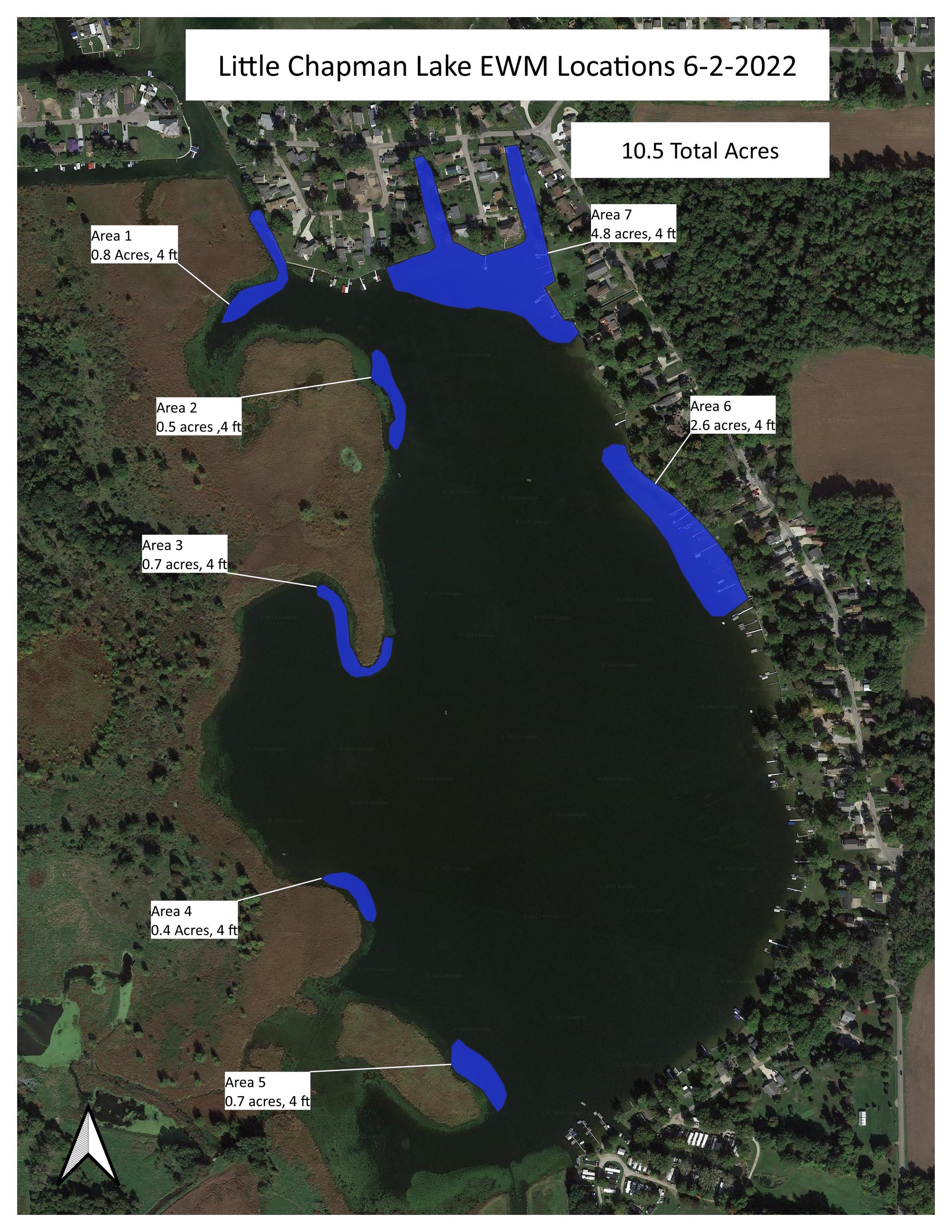Eurasian Water Milfoil locations as of June 2022 (Blue and RED) Areas
Eurasian Water Milfoil (EWF) has been present on Chapman Lakes for a number of years. EWF currently occupies roughly 47 out of the 638 acres of Chapman Lakes. EWM is an invasive species and tends to be very aggressive and create large dense infestations. Water Milfoil provides no nutritional value to wildlife nor fishes underwater. If left unchallenged, it will quickly overtake the water, make for an ugly sight and hinder activities like fishing, swimming, and water skiing.
The CLCA works with Aquatic Weed Control for treatment and surveys pinpoint invaded areas and develops a plan of action. The treatment of EMF is costly and the CLCA relies on donations to combat treatment.
What Can You Do?
When you take your boat out, check for invasives, remove the plug and drain all water before transport, and dump all unused bait in the trash.
Stay away from marked areas.
Attend the CLCA Annual Meeting where a representative from Aquatic Weed Control will be there to speak and answer questions.
Support the CLCA through membership or donations to the CLCA Lake Enhancement Fund.
Eurasian Water Milfoil Locations as of June 2022 (Blue) Areas
Eurasian Water Milfoil Information
Appearance: Eurasian Water Milfoil (Myriophyllum spicatum) has thin stems, which can appear, green, brown, or pinkish white. The stems grow to 1 - 3 meters in length and get progressively thinner the further they grow from the main stem. There are typically four feather-like, deeply-dissected leaves whorled around the stems with 14 or more uniform leaflets on each leaf.
Threat to Indiana Waters: Invasive species cause recreational, economic and ecological damage, changing how residents and visitors use and enjoy Indiana waters.
Eurasian Water Milfoil impacts:
Dense mats at the water’s surface inhibit water recreationists.
Overtakes habitat and out competes native aquatic plants, potentially lowering diversity.
Provides unsuitable shelter, food, and nesting habitat for native animals.
Creates and environment which can entangle swimmers.
What you should do: People spread starry Eurasian Water Milfoil primarily through the movement of water-related equipment. Fragments can get tangled in trailers, motors, anchors, and inside watercrafts (boats, canoes, and kayaks). Small fragmentations, which may be hidden in the mud and debris, can stick to trailer bunks, anchors, ropes, fabric, footwear, as well as scuba, fishing, and hunting gear. A small fragment can start a new population and it grows by spreading shoots underground.
Clean watercraft of all aquatic plants and prohibited invasive species.
Drain all water by removing drain plugs and keeping them out during transport.
Dispose of unwanted bait in the trash.
Dry docs, lifts, swim rafts and other equipment for at least 21 days before placing equipment into another water body.
Control Methods: Management of invasive aquatic plants involve either mechanical removal of plants or application of herbicides to public waters. Chapman Lakes Conservation Association is currently addressing non-native invasive weed control through L.A.R.E. (Lakes and Rivers Enhancement) grant.
For more information please visit:
https://nas.er.usgs.gov/queries/FactSheet.aspx?SpeciesID=237






